After the C5 Aircross, Citroën India impinged on the other end of the market with the C3. Now they aspire to contribute significantly to India’s electric vehicle (EV) revolution with the ëC3.
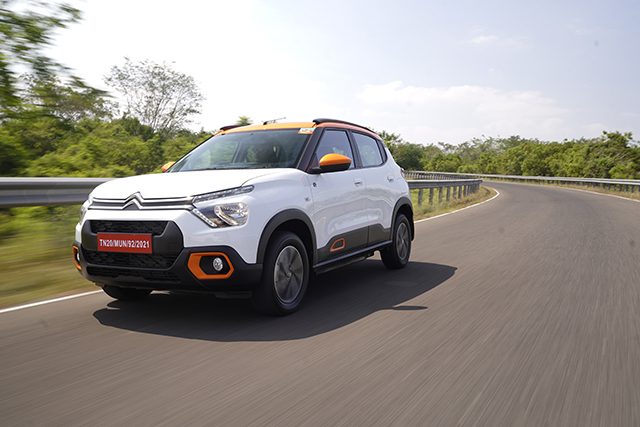
Story: Joshua Varghese
Photographer: Sanjay Raikar
Expectations of a high achiever are always astronomical. Their prowess in the past encourages one to expect the world of them in the present. Personally, I was looking forward to driving the ëC3 because it came from a manufacturer who has won multiple World Rally Championship (WRC) championships, introduced an innovative suspension system, and given us groundbreaking cars, including the Traction Avant, DS, and the iconic 2CV. A portfolio that currently includes the flagship C5 Aircross SUV and the C3 now shows the addition of the electric version of the latter, the ëC3, just six months after the launch of its internal combustion engine (ICE) sibling.

The C3 platform was developed for both ICE and battery electric vehicle (BEV) models and, therefore, the ëC3 is almost identical to the C3. In the absence of the badge and the green number-plates, telling them apart would be a tough task. For a car that is only 3,981-millimetres long, the Citroën designers have created a chic and modern exterior that holds at least one element of interest, regardless of which angle you choose to behold it from. The new Citroën logo blends into the chrome strips at the front while the contrast colour for the fog-lamp recesses add to the visual drama.
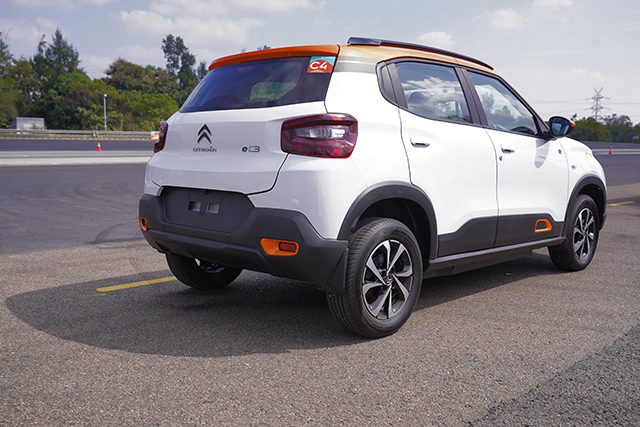
The designers’ play with the contrast continues in a small but noticeable way for the profile, also thanks to a splash of colour on the front doors’ cladding. Similar treatment has been given for the rear as well, though, in comparison, it appears to be this car’s least attractive angle. The car we drove also had a youthful dual-tone treatment that I appreciated but if that is not your fancy, Citroën offer up to three accessory packs and 47 customization options to choose from.

The interior has also benefited from the designers’ imagination and affinity for colour, but mostly for the front row. In our car, the greyish-black dashboard had a bright strip of orange that ran the width of the cabin. In the middle is a 10.2-inch touchscreen that offers the latest in smartphone connectivity, including the convenient wireless Android Auto and Apple CarPlay, a feature not available even in some cars above this segment. Other nice details about the cabin include the funky air-conditioner vents, complementing floor-mats and two USB ports for the rear passengers. While there are no soft-touch premium materials to highlight, the quality of plastic feels robust and durable. With one-touch power windows on offer, the lack of electrically adjustable mirrors (even in the top model) feels like an omission. Similarly, it would have been great if the instrument cluster were a more detailed unit. The display looks primitive next to the colourful infotainment screen and relays only the essentials, which is manageable; but it would have been better if the default screen had a percentage readout for the state of battery charge. Detailed statistics and reports will be available in the car’s dedicated smartphone app, though.
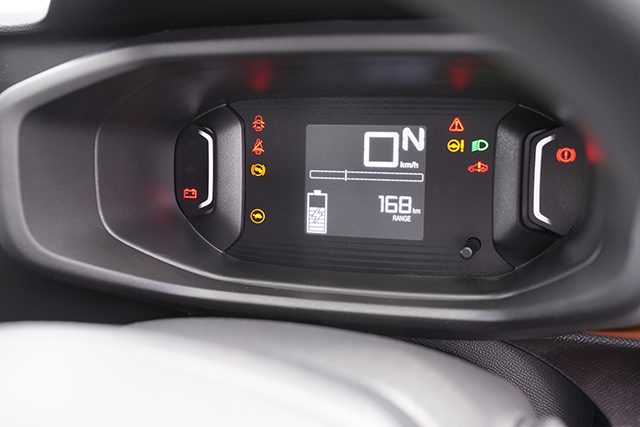
For a car this size, the ëC3’s use of space is quite clever and the fabric upholstery offers fairly comfortable seating. Even the second row is quite spacious but the floor is a bit higher than the C3’s due to this car’s battery placement. That deprives the tall passengers of thigh support. With the battery in the floor, Citroën could afford to leave the boot intact and even the ëC3 offers the same 315-litre boot volume, including the spare wheel. Furthermore, the rear seat folds flat for more space, if needed.
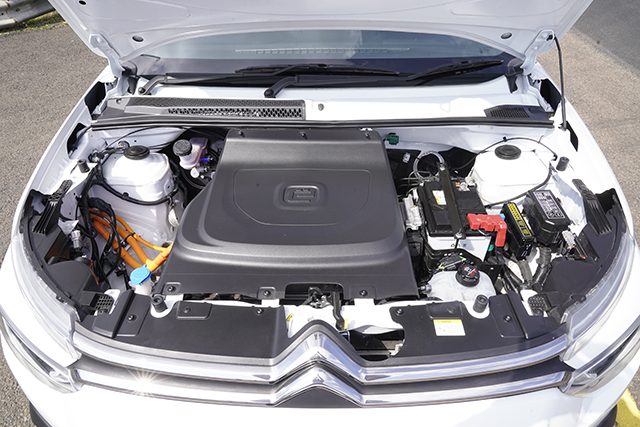
The ëC3’s power is supplied by a 29.2-kWh, air-cooled, LFP (lithium ferrous phosphate) battery pack. Citroën promise a range of 320 kilometres from a single charge, but we did not get a chance to verify it. They also claim that the car charges from 10 to 100 per cent using a 15A outlet in 10.5 hours while fast-charging from 10 to 80 per cent takes 57 minutes.
There are two drive modes on offer: Standard and Eco. It was with the former that my drive experience on the test-track got under way. One of the first things that impressed me was the line of sight from the driver’s seat. One can see the ends of the car clearly and that should make the ëC3 popular among new drivers and those who live in crowded cities. The 57 hp of power and 143 Nm of torque produced by the motor are sent to the front wheels. The throttle response is linear and the power delivery is smooth, making this a friendly car to drive. Similarly, the steering is also easy to use but one did wish for greater feedback at times. With the pedal to the floor, the ëC3 achieved the claimed 107 km/h (indicated) and felt planted at that speed with no cause for worry. The car’s low centre of gravity allowed me to take corners at a decent clip with confidence. However, the fun in a straight line is limited because the ëC3 takes a claimed 6.8 seconds to accelerate from 0 to 60 km/h.
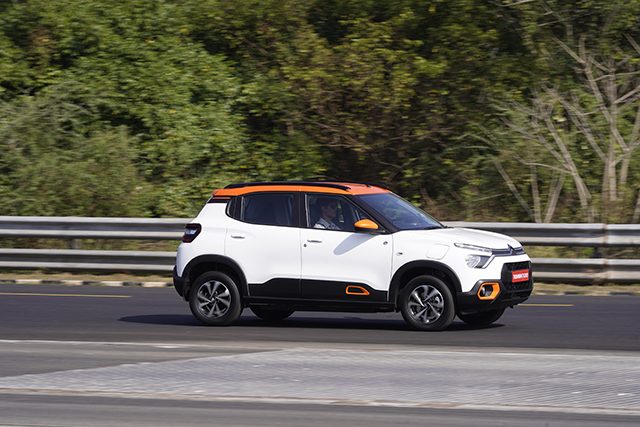
The suspension is, of course, one of Citroën’s strengths but our experience was limited to the straights and corners of the smooth test-track. The set-up offered a plush ride quality worthy of the manufacturer’s reputation and it holds great promise in the real world too. Regenerative braking is already at work when one takes the foot off the accelerator but for faster deceleration, the ëC3 relies on disc brakes at the front and drum units at the rear. Airbags are available for driver and passenger; however, at the time of going to press, we were unable to source any information about the C3 or the ëC3’s GNCAP safety ratings.
The ëC3 is Citroën’s ticket to the big league because they are determined to be among the first runners for the most accessible electric car. There are a considerable number of people sitting on the fence who are ready to pick up a small electric car for everyday use and, given the right motivation, they could be converted into buyers. Taking that into consideration, it is unfortunate that we did not get to drive the ëC3 in the environment where it is supposed to perform and so evaluate it better. However, we look forward to that opportunity soon. So far as first impressions go, the overall experience of our time with the ëC3 was positive.
As mentioned earlier, there are a few things that need improvement but none of them is grave enough to overshadow the potential of this car. The Tata Tiago.ev appears to be this car’s main rival at the moment but its head-on competition would be an electric Tata Punch (not launched yet). If priced right, this compact hatchback could easily be among the first options for a new electric car-buyer or even someone’s first car ever. We expect it to be priced between Rs 9-12 lakh and, no, not introductory pricing.
Watch the video review here:
Also Read: Land Rover Range Rover L D350 – Above and Beyond




